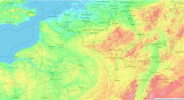I think the estimates for journey times are very optimistic
They are very optimistic I admit, however physically doable. The question is at what price?
longer than the straight line anticipated
If you start the new tracks exactly at the Fretin triangle junction, straight to each station mentioned on the project, and end at the High speed Line at Bruchsal, there will be in total 422Km (dead straight line). I imagine in a real scenario 450km of new tracks could be achieved if the proper effort ($$$) is dedicated. Concerning the average speeds, I calculated an average of 350Km/h, although it could be higher. I truly believe that 7000m curve radius is definitely achievable, altough I would argue why not make it 10000m and aim for even higher maximum speeds. Make the distance between tracks 5,5m and perhaps when this line is done in 20 years, trains going @450Km/h would be the new norm.
I used the website below to track distances and elevation lines.
https://www.arcgis.com/apps/Profile/index.html?appid=fb052ab397f045ea999525f6b57e702e
And the times are way out if any intermediate stops are expected, as suggested.
Of course, these ideal times are transfers without stops, and I believe that some cities can offer this without any stops, such as Frankfurt, Munich, Zurich, Luxemburg, Karlsruhe, Stuttgart, Ulm, Augsburg, Basel. Trains coming from more distant and smaller cities would stop at these strategic cities before traveling non-stop to london. Those smaller or farther cities are also strategic cities which would deserve a direct route to London, however not compelling enough to have non stop service to London, therefore making a connection inbetween. Cities such as Innsbruck, Salzburg, Nüremberg, Memmingen, Kempten, Bern, Regensburg, Ingolstadt, Vienna, Chur, Vaduz, Milan. Of course, optimizing routes in order to maximize the consumer's utility and minimize waste is something very complicated, however I'm sure that extremely capable people have already developed algorithms for this.
and let’s not forget it runs through the Ardennes
Honestly, considering the complexity of several engineering projects in human history, such as the Channel Tunnel itself, and several high-speed routes cutting through the Alps, I do not believe that our best engineers and designers, with the help of the best rail tracing software are not able to resolve this issue.
I mentioned the new long distance station being built at Stuttgart airport, in 2009 the price was estimated at 52 million euro, and there is nothing special about it, and it doesn´t have to be, it is basically a 500m tunnel bored by a TBM and an island platform between two tracks, some elevatores, stairs, escalators, just like houndreds of subwaystations around the world, simple. However, I imagine at Luxembourg it would have to be 4 tracks instead of two, but one could simply copy and paste parallel stations like the one in stuttgart airport. Plus some extra emenities, but nothing too fancy as the infrastructure above would still have normal use. Honestly, I don't see the 4-platform underground station in Luxembourg costing more than 500 million euros. And all the others in the intermediate cities, with underground stations with 2 platforms, for 200 million euros each in today´s money.


